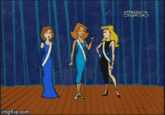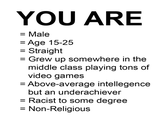There Are No Girls on the Internet
Confirmed 769,538
Part of a series on Rules of the Internet. [View Related Entries]
Featured Episode
There Are No Girls on the Internet
Part of a series on Rules of the Internet. [View Related Entries]
Featured Episode
About
"There are No Girls on the Internet" is a tongue-in-cheek adage which implies that there are no female entities actually participating in online activities, especially when it comes to anonymous exchanges in chatrooms and discussion forums. The outdated myth also jests that the Internet is essentially a "sausage fest" dominated and defined by male internet users and a smaller population of male trolls or griefers who pose as women in pursuit of lulz. The catchphrase also describes how any female privilige (percieved as social benefits got from the sex) on the Internet is stripped away.
Origin
The origin of the myth can be traced back to the male-prevalent days of Usenet, particularly in the virtual Multi-User Dungeons (MUDs), a genre of text-based online role-playing games and predecessor to MMORPG like World of Warcraft. During this era, it became a routine practice among male players to falsely pose as girls to solicit gifts or other unfair advantages. Such prevalence of gender swapped deception in MUDs was first noted in 1993 by American sociologist Amy Bruckman in her research paper "Gender Swapping on the Internet":
"Many people, both male and female, enjoy the attention paid to female characters. Male players will often log on as female characters and behave suggestively, further encouraging sexual advances. Pavel Curtis has noted that the most promiscuous and sexually aggressive women are usually played by men. If you meet a character named "FabulousHotBabe," she is almost certainly a he in real life."
The practice has since remained a popular trolling technique in online conversations and more recently, as an integral part of griefing in the context of online gaming. In addition, such stereotype of the average Internet user as "a geeky male who is single and desperately seeking interaction with the other sex" became further amplified and perpetuated through its frequent portrayal in popular TV shows, films and novels.
Spread
As the Internet evolved into something far more accessible for the general population throughout the 1990s and 2000s, the myth of "no girls on the Internet" also entered a new chapter with the widespread use of A/S/L, a shorthand for age / sex / location, in AOL chatrooms and instant messaging. Such disproportionate level of attention given to self-described female Internet users in chatrooms even led to a trend of spambots disguised under overtly feminine screen names like "superhotgirl142" or "LFOforever99."
The myth continued to spread across other influential hubs of the Internet culture in the early 2000s, most notably B3TA Forum,[2] General Mayhem, Something Awful, [9] FARK, Newgrounds and 4chan. Meanwhile, a plausible theory began to emerge in the said forums that female internet users were prone to pose as men as to avoid verbal harassment and other burdens of unwanted attention. The first Urban Dictionary definition for the phrase "There are no women on the Internet" was submitted on January 23rd, 2007,[5] which read:
The term is coined in the fact that most people who use the internet are male.
TITS or GTFO
Due to the widespread nature of "No Girls on the Internet" and similar adages, identifying oneself as a "girl" within certain communities (ex: 4chan) has become a hilariously arduous task, often leading to an inquiry of documented evidence or time-stamped profile photos from skeptic netizens. As encapsulated in the catchphrases "TITS or GTFO" and "Pics or It Didn't Happen", the burden of proof often rests on the shoulder of those who claim to be "not dudes." The popularity of both axioms eventually led to their inclusion in the Rules of the Internet, a list of protocols for Anonymous users first drafted on 4chan and Encyclopedia Dramatica [6] sometime in 2007, as well as spawning several derivative sayings like "The Internet, where men are men, women are also men, and children are FBI agents" and "All fanfic writers are girls."
Usage in MMPORGs
The practice of gender-bending can be still observed in today's MMPORGs. The prime example is griefing (online gaming equivalent of trolling) on World of Warcraft (WoW), the largest MMPORG game with over 12 million subscribers in the world. In 2005, The Escapist Magazine's Whitney Butts wrote[3] about the prevalence of gender deception in the WoW community in an article titled "OMG Girlz Don't Exist on teh Intarweb!!!!1":
"I've been watching and observing the internet for quite some time now. It's like a science project with the usual control and variables. The control is: I am a girl. The variables are the medium through which this fact is expressed. The results all point to the same paradoxical conclusion: I am a girl, but girls do not exist on the internet."
Internet Usage Statistics
In contrast to this long-standing myth, more recent studies of the online demographic have found that the gender gap in internet usage is closing in. According to a 2006 statistics report released by PEW Internet & American Life Project,[14] 86 percent of younger women (ages 18 to 29) were online, compared with 80 percent of men in the same age group. Despite the recent development, the same report also found men to be in the overall lead of online activities, representing somewhere between "68 percent to 66 percent of internet users."
Search Interest
Google Insights graph shows the phrase came into popular usage sometime in early 2008; Google search results show the phrase "No Girls on the Internet" has been in existence for sometime, since early 2005; "TITS OR GTFO" has been popularly used since 2006.
External References
[1] The Internet Society – GENDER SWAPPING ON THE INTERNET
[2] B3TA Forum – Search Results for No Girls on the Internet
[3] The Escapist Magazine – OMG Girlz Don't Exist on teh Intarweb!!!!1
[4] Washington Post – Women Narrow the Internet Gender Gap, Survey Finds
[5] Urban Dictionary – There are No Women on the Internet
[6] Encyclopedia Dramatica – No Girls on the Internet (NSFW)
[7] The Daedalus Gateway – Gender-Bending
[8] MTV – Gender-Bending Online Gamers Bending Rules In 'Warcraft'
[9] Something Awful – Epic Mounts: Love in Warcraft
[10] IGN Blog (via Wayback Machine) – Why guys cross-play as girls
[11] Project Lore (via Wayback Machine) – Chinese Company Challenges Gender Bending in MMOs
[12] YouTube – No Girls on the Internet
[13] Culture and Communication (via Wayback Machine) – Wait, Did 4han Just Enlighten Me?
[14] PEW Internet – How Women and Men Use the Internet
[15] VirtualPolitik – There are No Girls on the Internet
Recent Videos 6 total
Recent Images 38 total
Share Pin




















Comments ( 87 )
Sorry, but you must activate your account to post a comment.
Please check your email for your activation code.